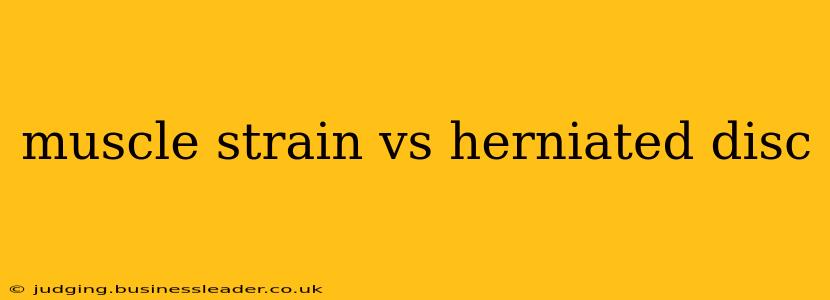Back pain is a common ailment, affecting millions worldwide. Two frequent culprits are muscle strains and herniated discs. While both can cause significant discomfort, understanding their differences is crucial for proper diagnosis and treatment. This article will delve into the distinctions between muscle strains and herniated discs, addressing common questions and helping you better understand your back pain.
What is a Muscle Strain?
A muscle strain, also known as a pulled muscle, occurs when muscles in your back are overstretched or torn. This often happens due to sudden movements, heavy lifting, or repetitive strain. The severity of a muscle strain can vary from mild discomfort to debilitating pain.
Symptoms of a Muscle Strain:
- Localized pain: Pain is usually felt in the specific muscle group affected.
- Muscle spasm: The affected muscle may spasm, causing tightness and increased pain.
- Tenderness to the touch: The strained muscle will be sensitive to palpation.
- Limited range of motion: You might experience difficulty bending, twisting, or extending your back.
- Swelling: In some cases, swelling might be present around the strained muscle.
What is a Herniated Disc?
A herniated disc, also called a slipped or ruptured disc, occurs when the soft, gel-like center of an intervertebral disc pushes through a tear in the tough outer layer. These discs act as cushions between the vertebrae in your spine. When one herniates, it can put pressure on nearby nerves, causing pain, numbness, or weakness.
Symptoms of a Herniated Disc:
- Radiating pain: Pain often radiates down the leg (sciatica) or arm, following the path of the affected nerve.
- Numbness or tingling: Numbness, tingling, or weakness can occur in the leg or arm.
- Weakness: Muscle weakness in the leg or arm is a common symptom.
- Reflex changes: Changes in reflexes can also be observed.
How Can I Tell the Difference Between a Muscle Strain and a Herniated Disc?
Differentiating between a muscle strain and a herniated disc can be challenging, even for medical professionals. Many symptoms overlap, and a proper diagnosis often requires a thorough examination. However, some key differences can help guide you:
- Location of Pain: Muscle strains typically cause localized pain in the back, whereas herniated discs often cause radiating pain down the leg or arm.
- Nerve Involvement: Herniated discs frequently involve nerve compression, resulting in numbness, tingling, or weakness. Muscle strains rarely cause these symptoms.
- Onset: Muscle strains often occur suddenly following a specific event, while herniated discs might develop gradually over time or after a traumatic event.
What are the Treatment Options for Muscle Strains?
Treatment for muscle strains usually involves conservative methods:
- Rest: Avoid activities that aggravate the pain.
- Ice: Applying ice packs for 15-20 minutes at a time can help reduce inflammation.
- Heat: After the initial inflammation subsides, heat can help relax muscles.
- Over-the-counter pain relievers: Medications like ibuprofen or naproxen can help manage pain and inflammation.
- Physical therapy: Physical therapy can help strengthen muscles and improve flexibility.
What are the Treatment Options for Herniated Discs?
Treatment for herniated discs also often starts with conservative methods:
- Rest: Avoiding activities that worsen pain is crucial.
- Medication: Pain relievers, muscle relaxants, and anti-inflammatory drugs can provide relief.
- Physical therapy: Strengthening core muscles and improving posture can help alleviate pressure on the disc.
- Epidural steroid injections: Injections can help reduce inflammation and pain.
- Surgery: In severe cases where conservative treatments fail, surgery may be necessary.
Can a Muscle Strain Lead to a Herniated Disc?
While a muscle strain itself doesn't directly cause a herniated disc, chronic muscle imbalances and poor posture associated with untreated muscle strains can contribute to increased stress on the spine over time, potentially increasing the risk of a herniated disc. Maintaining good posture and strengthening core muscles can help mitigate this risk.
How are Muscle Strains and Herniated Discs Diagnosed?
Diagnosis usually involves a physical examination and a review of your medical history. Imaging tests, such as X-rays, MRIs, or CT scans, may be used to confirm the diagnosis and rule out other conditions.
When Should I See a Doctor for Back Pain?
You should seek medical attention if your back pain:
- Is severe or doesn't improve with home treatment.
- Radiates down your leg or arm.
- Is accompanied by numbness, tingling, or weakness.
- Is accompanied by fever or bowel/bladder changes.
This information is for general knowledge and does not constitute medical advice. Always consult a healthcare professional for accurate diagnosis and treatment of back pain. They can perform a proper examination and determine the best course of action based on your individual needs.
